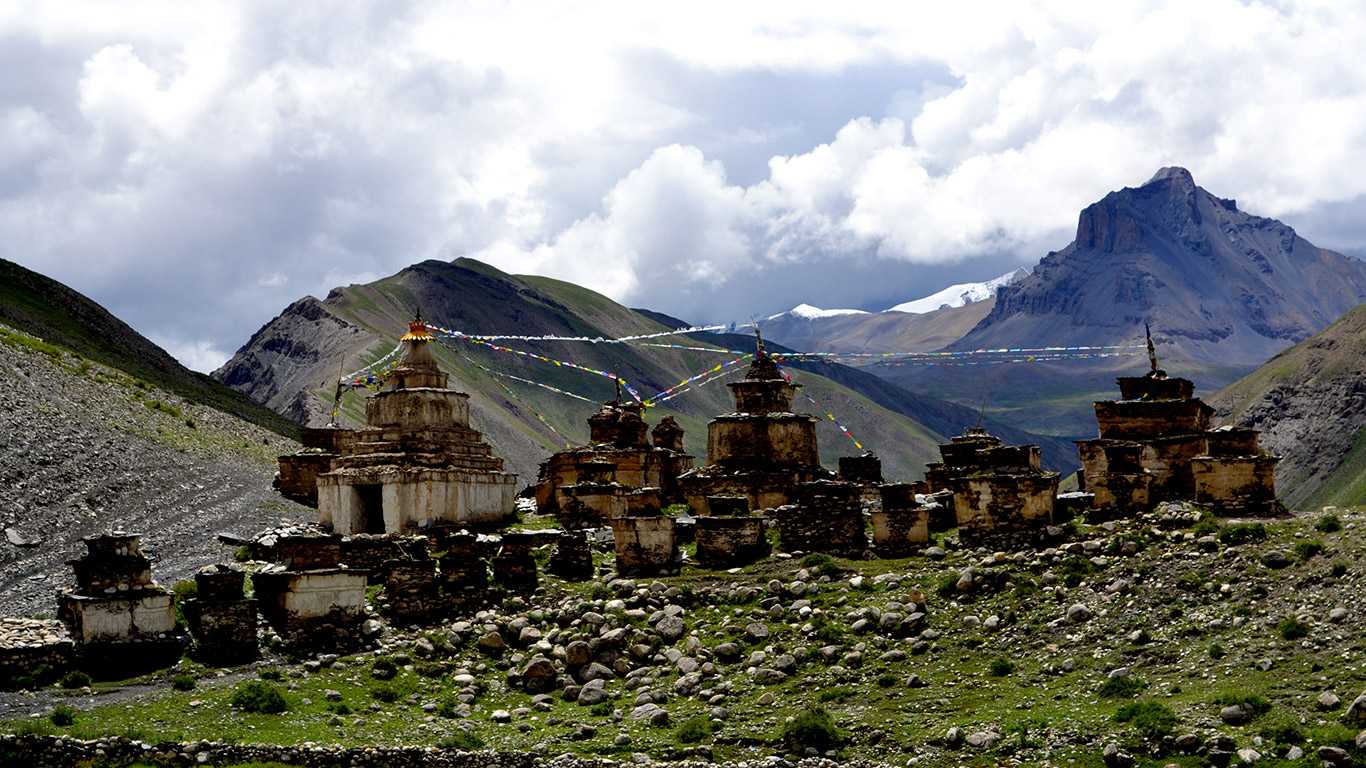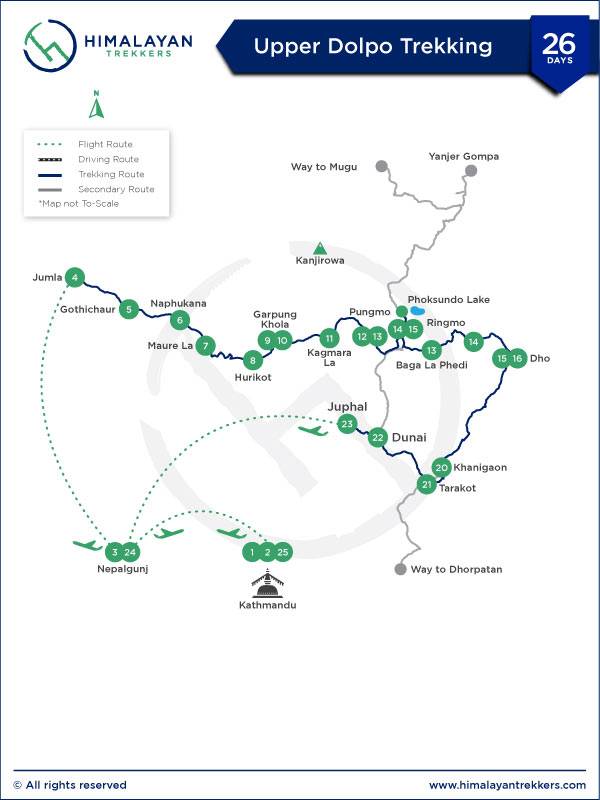Upper Dolpo Trek: 27 Days Itinerary and Cost Considerations Overview
Upper Dolpo Trek is a wonderful journey to one of the remotest regions of Nepal. It is one of the most challenging and thrilling trekking trails between the Dhaulagiri mountain range and the Tibetan plateau in Nepal's mid-western region. Upper Dolpo Trek 27 days journey is ideal for those of us who can commit to a two-week or longer vacation in order to experience the true mountain lifestyle and hypnotic Himalayan environment in a remote region of the planet.
Opened not a long time ago for the outsiders, the Upper Dolpo is considered unquestionably one of the top trekking destinations in Nepal's Himalayas today due to the beauty of culture and nature. However, because of its isolated position and lack of links and transportation, the Dolpo region has remained off the radar of most of us despite its incredible natural and cultural splendor.
Our 27 Days Upper Dolpo Trek Itinerary makes you walk through gorgeous valleys, multi-ethnic settlements, and the majestic Himalayas including Annapurna, Dhaulagiri, and Kanjiroba, to name a few, luxuriant forests rhododendron, pines, oaks, and gives you an experience of the splendor of the rugged and remote far western region of Nepal. The Upper Dolpo Trek also goes through Lower Dolpo, which was once its own little kingdom.
Some of the rewards of this trek are observing Tibetan Buddhist culture, Shey Phoksundo Lake, rare wildlife like snow leopards, and epochs of old monasteries - for instance, the 800-year-old Shey Monastery. This 27 Days Upper Dolpo Trek Itinerary further allows you to explore the largest park in Nepal – Shey Phoksundo National Park. Shey Gompa is the primary attraction of this Dolpo journey where centuries-old Buddhist and Bonpo traditions are still practiced alongside shamanistic influences.
The perennial rivers, strikingly attractive and roaring waterfalls, green meadows, diverse wildlife, and more importantly the 3 mountain passes above 5000 meters altitude will keep you entertained and interested throughout your trekking trails.
Trip Highlights
- Trekking experience through the largest national park of Nepal - Shey Phoksundo National Park with a variety of flora and fauna
- Exotic views of the turquoise waters of Lake Phoksundo
- A glimpse of rare and endangered mammals such as snow leopards and blue sheep
- Opportunity to explore Shey Gompa, which is believed to be 800 years old
- The remote lifestyle of locals and followers of Bon Buddhism
- The best views from Kang Taiga (5950 meters)
- Views of Mount Dhaulagiri and Mount Annapurna II
Difficulty during Upper Dolpo Trek
There are various factors that level up the difficulty of a Himalayan trekking journey. First and foremost, the long itinerary of the Upper Dolpo that requires almost 21 days of several steep ascents and descents on the desert-like topography makes the trek difficult.
With two 5,000m high mountains to cross and several days spent above 4,000m, this trek is not for the faint of heart. Kang-La Pass, at 5,151 meters, is the highest point in this trek. And the risk of altitude sickness is considered to begin at levels exceeding 3,500 meters. As a result, acclimatization is critical for this climb. If you feel any of the symptoms such as uneasiness, breathing difficulties, headaches, increased heart rates, nausea and vomiting, difficulty sleeping, etc. you need to inform the guide or the trek leader as soon as possible as they have extensive first aid training and are well-experienced in the Himalaya. But, being hydrated, taking your time, and being aware of your body can help you avoid major altitude difficulties.
It's worth noting that Upper Dolpo is the country's least developed region. It's not just the altitude that causes problems; remoteness and a lack of basic amenities are also issues.
Another factor trekkers need to study before making their trip to Upper Dolpo is the overall conditions of the region during the different seasons. You must be aware of the best time to visit the region from the locals or the experienced.
While some familiarity with high-altitude treks is advantageous, anyone can hike without specialist knowledge or climbing equipment. You must, however, be in the excellent physical condition and mental determination, as well as have a high level of walking stamina. So, we advise you to indulge in some cardio-vascular activities, hiking trips, and physical sports more than a couple of months prior to the trip departure.
Therefore, trekking to Upper Dolpo isn't easy in the strictest sense but is very rewarding.
Upper Dolpo Trekking in different seasons
Trekking in Upper Dolpo is best done during the spring and autumn. It is possible to do this trek in the summer/monsoon as Upper Dolpo falls in the rain shadow area. And it is not advisable to go trekking during the winter months due to excessive snowfall. In details:
Upper Dolpo Trek in Spring Season
The spring season is the best season to trek in Nepal. The weather and temperature in spring are pleasant with a bright sky. The clear sky and stable weather mean there are fewer risks of flight cancellations in Juphal, the trek's starting point. With the temperatures beginning to rise in mid-March, the trekking trails gradually become visible. The post-winter season allows Snow Mountains to be viewed at their best. There will be breathtaking vistas of the central Himalayan range. The rhododendron blossoms will be blossoming at their peak along the way, with a wide range of hues in the lower region.
However, during the early spring, snow can be an issue in the Upper Dolpo, making it difficult or impossible to cross some passes. The optimum spring months for Upper Dolpo are from late March until the end of May.
Upper Dolpo Trek in Summer/Monsoon Season
Some of the trekking journeys in Nepal during the monsoon season are not recommended. However, some places like Upper Mustang and Upper Dolpo are rain-shadow locations in western Nepal. No rain means those places are accessible during the summer/monsoon season. The high passes are snow-free, the landscapes are lush, and the paths are well-marked with locals' footsteps during this season.
The only concern during the monsoon for Upper Dolpo Trips is a strong likelihood of flight cancellations arriving in Juphal due to the overcast weather and heavy rain in the lower regions.
Upper Dolpo Trek in Autumn Season
Out of all seasons, autumn is regarded as the ultimate time for treks in Nepal including the Upper Dolpo Trek. The skies are bright and blue after the summer monsoons, providing many picturesque moments of glittering nature and the majestic Himalayas. Additionally, you can mingle with the inhabitants, many tiny villages, and communities on their journey to the Upper Dolpo during the fall harvest season. Though November is an autumn month, snow is likely to be seen starting from this time in the Upper Dolpo Region. So, we recommend you come early or come prepared.
Upper Dolpo Trek in Winter Season
The temperature slowly begins to drop in November, especially during the nighttime, and continues to do so for the next few months. Due to the harsh cold temperature, impassable passes, and snow-covered trails, winters are not recommended for the trek in Upper Dolpo.
Permits to trek in Upper Dolpo
Trekkers need to carry three permits to do the Upper Dolpo Trek:
1. Lower Dolpo Restricted Area Permit
2. Shey Phoksundo National Park Entry Fee
3. Upper Dolpo Restricted Area Permit (US$500 entrance fee for the first ten days and an additional US$50 per day after that)
Note:Trekkers are not permitted to trek alone in restricted zones. As a result, you are unable to apply for restricted area permits on your own. But, you do not have to worry about it as we, Himalayan Trekkers have the cost of the permits included in the package cost and we will be obtaining all the permits for you.
Because of the comparatively hefty permit cost, the number of trekkers in the area is limited, contributing to Upper Dolpo's status as one of Nepal's most exclusive and unforgettable experiences.













